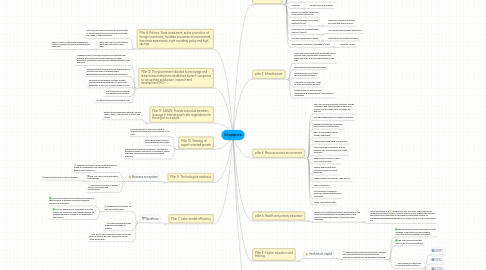
1. Pillar 1- Institutions
1.1. the party of the action of the people (PAP)
1.2. review committee of the economy (CRE)
1.2.1. They were created for the economy to return to sustainable economic level, and implement policies to make the country more competitive
1.3. Development Board.
1.4. Government Agency of development of the industry.
1.5. commercial Unions
1.5.1. drought to attract foreign investment
1.6. National Wages Council
1.6.1. regulator of wages.
1.7. NTUC
1.7.1. repartís the interests of workers
1.8. The MITA
1.8.1. law that limits publications
1.9. Review Committee censorship lifting certain restrictions.
1.10. Board investigation for corrupt practices (ISSC):
1.10.1. reports of corruption practices of private and public sectors.
1.11. Association of Southeast Asian Nations (ASEAN):
1.11.1. provide leverage in trade negotiations.
1.12. Economic Development Board:
1.12.1. single point for foreign investment.
1.13. The Monetary Authority of Singapore (MAS)
1.13.1. monetary control.
2. Pillar 8: Policies: State investment, active promotion of foreign investment, facilitate procomercial environment, free trade agreements, tight monetary policy and high savings.
2.1. JDE(Junta de desarrollo económico)Its aim was to attract foreign investors more than covering the needs of their businesses.
2.2. Initial goal: direct investments to industries that involve more labor.
2.2.1. Repair of ships, metallurgical engineering, chemical industry, electrical equipment and apparatus
3. pillar 2: Infrastructure.
3.1. Clean and Green Movement: encourage care to beautify their surroundings, planting trees, palms and bush: and thorough cleaning of the river.
3.2. Improvement of the drainage system.
3.3. Development of facilities to house foreign companies.
3.4. Corporate Jurong Town: ready to build and operate factories
3.5. Infrastructure for research and manufacturing. Establishment of schools and universities
4. Pillar 12: The government decided to encourage and attract new enterprises established biotech companies to set up their production, research and development(I+D)
4.1. Singapore plans to provide infrastructure along with the financial and intellectual capital necessary to make biomedical services an important and sustainable part of the economy.
4.2. The government made significant investments to promote new ways of teaching while encouraging innovation grants and recognition.
4.3. Educational partnerships to study outside Singapore with the obligation to return after graduation to work for a fixed number of years.
4.4. Build the basis of scientific knowledge of the country.
4.5. JDE think technology investment fund
5. Pillar 11: ASEAN: Provide individual members leverage in international trade negotiations for the region as a whole.
5.1. Bilateral trade agreements with the United States, Japan, New Zealand, Australia and Mexico.
6. pillar 3: Macroeconomic environment
6.1. CRE: tax cuts and incentives to attract foreign investment and talent to balance the loss of revenue and increased taxes on goods and services.
6.2. Find the independence of foreign economies.
6.3. Strategies ecosystem, innovation and economic diversification.
6.4. labor Inconformidad risking foreign investment.
6.5. Liberties hiring and firing of empelados
6.6. Clean and Green Movement: how to beautify their surroundings and create attraction.
6.7. beautification project: project more cost-effective.
6.8. Salaries high government officials to prevent corrupt practices.
6.9. Implementation of alliances: Sean and TLC.
6.10. State Companies
6.11. Act incentives to promote economic expansion attracting companies.
6.12. MORE: low inflation rates
7. Pillar 10: Strategy of export-oriented growth
7.1. Eliminate almost all tariffs and invest in improving infrastructure and efficiency of its ports.
7.2. British naval bases became abandoned ship repair sites.
7.3. International Enterprise Singapore: I cast the first processing system TRADENET e-commerce, which improved the efficiency and turnaround time business.
8. pillar 4: Health and primary education
8.1. health: much of the infrastructure and people for the study and development of the health sector and thus encourage the growth of this sector were dedicated.
8.1.1. forces biomedical R & D: research of 2,000 scientists and professionals Singapore education system: it had to adopt and fully support the method that implemented new ways of teaching promoting the creation of scholarships strengthening education by schools such as John Hopkins and MIT.
9. Pillar 9 : Technological readiness
9.1. Business ecosystem
9.1.1. Singapore focused on diversifying its economy, based on knowledge to be a global hub for business and Inversions
9.1.2. The JDE think Fund investments in technology
9.1.2.1. to invest directly in private companies
9.1.3. Chua said it will invest in human capital, technology and infrastructure
10. Pillar 5 : Higher education and training
10.1. Intellectual capital
10.1.1. Singapore the traditionalist education method was criticized because rote memorization repressed creativity and entrepreneurial thinking
10.1.1.1. The government made investments for new methods of education and encouraging innovation with scholarships and awards
10.1.1.2. The JDE planned to bring at least 10 world-class institutions
10.1.1.3. Four divisions of labor that promote scientific research
10.1.1.3.1. BMRC
10.1.1.3.2. SERC
10.1.1.3.3. CPAD
10.1.1.3.4. BMRC
11. Pillar 6: Goods Market Efficiency
11.1. External Relations
11.1.1. The Ministry of Commerce and Industrial intended to justify the actions of Singapore as necessary to accerder to freer markets.
11.1.2. In 2002 Singapore regards China as its next market opportunity and as a significant threat.
11.1.3. Singapore has little experience with import substitution, and realized that its domestic market were too many guys.
12. Pillar 7: Labor market efficiency
12.1. Workforce
12.1.1. Singaporeans are known for their strong work ethic
12.1.1.1. 1970 The JDE had success attracting investors to their projects as workforce because singapuer had run out of workers.
12.1.1.2. In 2002 Singaporeans considered leave the country for factors such as; the high level of life, stressful education system and a government that ignored.
12.1.2. LEE gave proposal that was supporting the rights of workers
12.1.3. LIM BOON HENG said the unions realize that much of what is good for business is as well good for workers.
